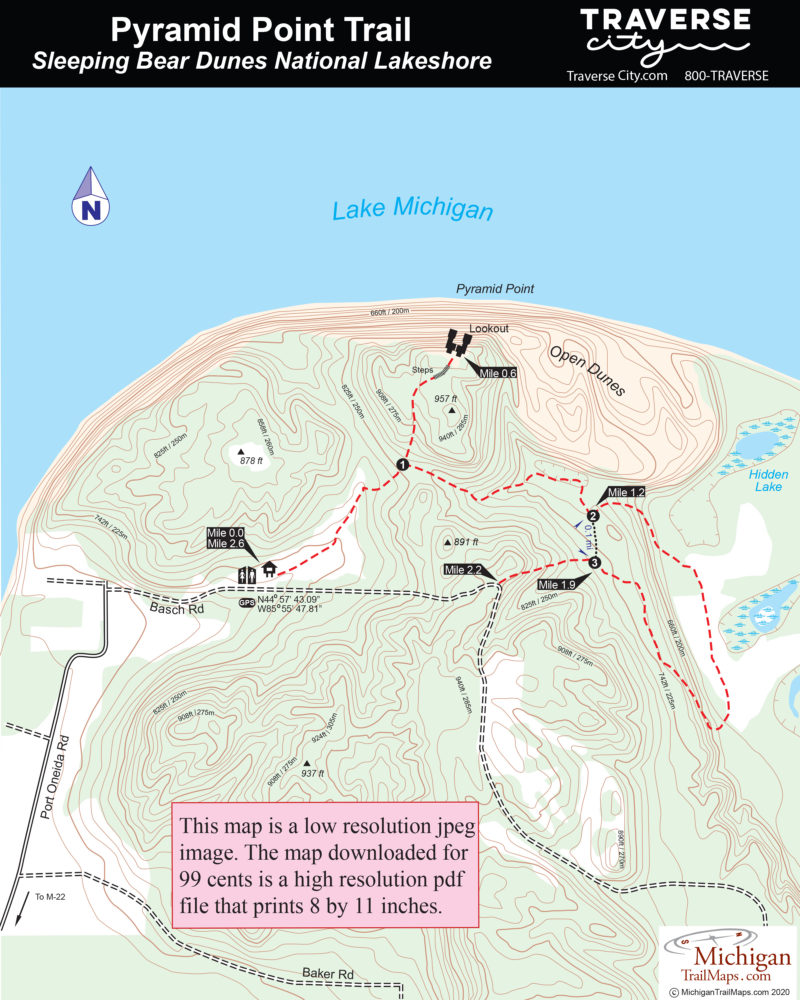The trail begins in a grassy field, the remnants of one of those 19th century farms, but quickly enters the woods and begins climbing. At Mile 0.4 you reach post No. 1 where you head left for the viewing point known as the Lookout. The final stretch is a bit steeper and At Mile 0.6 from the parking lot you breakout out of the trees on the edge of a perched dune.
[On the trail at Pyramid Point.] The dune puts you 260 feet almost straight above the lapping waters of Lake Michigan which is why it attracted the hang gliders when their sport was peaking in popularity in the late 1970s. The daredevil pilots would haul their equipment to the Lookout and then use the wind currents that came up the side of the steep dune to soar for an hour or two over Lake Michigan.
If they were good they could land back at their car in the parking lot. If not they would end up on the beach and be faced with an even steeper climb then the trail to the Lookout.
You never see hang gliders anymore because they fly inland and where they are towed up by an airplane. The view, however, is still the same. One reason the overlook is so dramatic is because the point is the closest spot on the mainland to the Manitou Islands. You not only get an eyeful of North and South Manitou Islands but also any freighter in the area as Pyramid Point forms the south side of Manitou Passage, a popular shipping lane.
From the Lookout you backtrack to post No. 1, follow the left-hand fork and continue the descent through a beech-maple forest. After dropping 130 feet you bottom out where a migrating dune is slowly spilling its sand among the hardwoods and quickly arrive at post No. 2 at Mile1.2 from the trailhead. To the west (right) is the cross-over spur that shortens the hike to 2 miles. Head southeast (left) and another rapid drop ends in an open area created when farmers arrived here after the Civil War. The last farm was gone by the 1930s. Today the meadow is a beautiful spot, a grassy area hemmed in by forested dunes on one side and framed by birch and beech on the other. Blue standards lead you through the length of the meadow and re-direct you back into the woods at its south end.
The trail now regains all the elevation lost on the previous leg. But the 0.4-mile ascent is a scenic one if the leaves have already dropped, for you can view the entire meadow along with the Lake Michigan shoreline. At post No. 3, you head west (left) for the final leg to Basch Road. This stretch holds the steepest climb of the day, with a deep ravine running along the south side of the trail. Within 0.3 mile of the last junction, you break out at the dirt road, where a post directs you to head west (right). It\'s a downhill walk along Basch Road for 0.4 mile to the trailhead parking area.
Normally I detest any hike that ends as a road but Basch Road makes for a scenic finish. It\'s a narrow dirt road that winds and curves through a forest so thick that its foliage forms a canopy overhead. Even on the hottest days this is cool end to a hilly hike.








